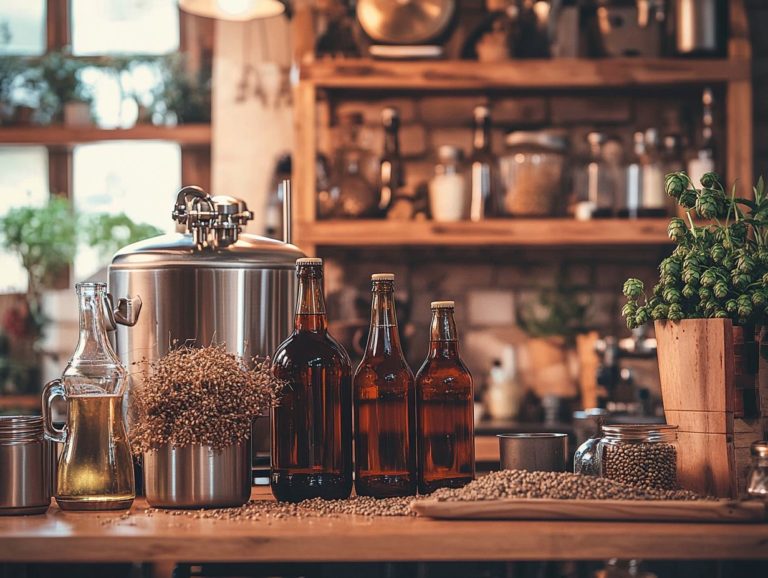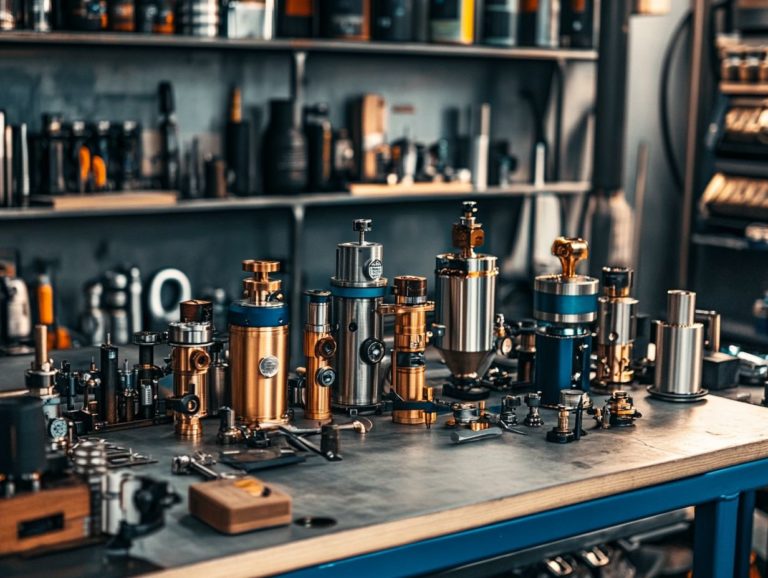Best Practices for Storing Brewing Equipment
Properly storing your brewing equipment is crucial, whether you’re just starting out or have been perfecting your craft for years. It not only preserves the quality of your brew supplies but also prevents unnecessary damage, ultimately saving you valuable time and money in the long run.
This article delves into which pieces of equipment require careful storage, the ideal conditions for keeping them safe, and practical home brewing tips to ensure your brewing tools and ingredients remain in peak condition.
Uncover how implementing the right storage practices can truly elevate your homebrewing journey!
Contents
- Key Takeaways:
- Why is Proper Storage Important?
- Saves Time and Money
- Equipment Storage Essentials
- 3. Ingredients
- Where Should Brewing Equipment be Stored?
- 1. Temperature and Humidity Levels
- 2. Light Exposure
- 3. Accessibility
- How to Properly Store Brewing Equipment and Ingredients?
- 1. Clean and Dry Equipment
- 2. Use Airtight Containers
- Frequently Asked Questions
- What are the best practices for storing brewing equipment?
- How should I clean my brewing equipment before storing?
- Can I store my brewing equipment in the fridge or freezer?
- What is the best way to prevent pests from getting into my stored brewing equipment?
- Should I store my brewing equipment in a specific order?
- How often should I check on my stored brewing equipment?
Key Takeaways:
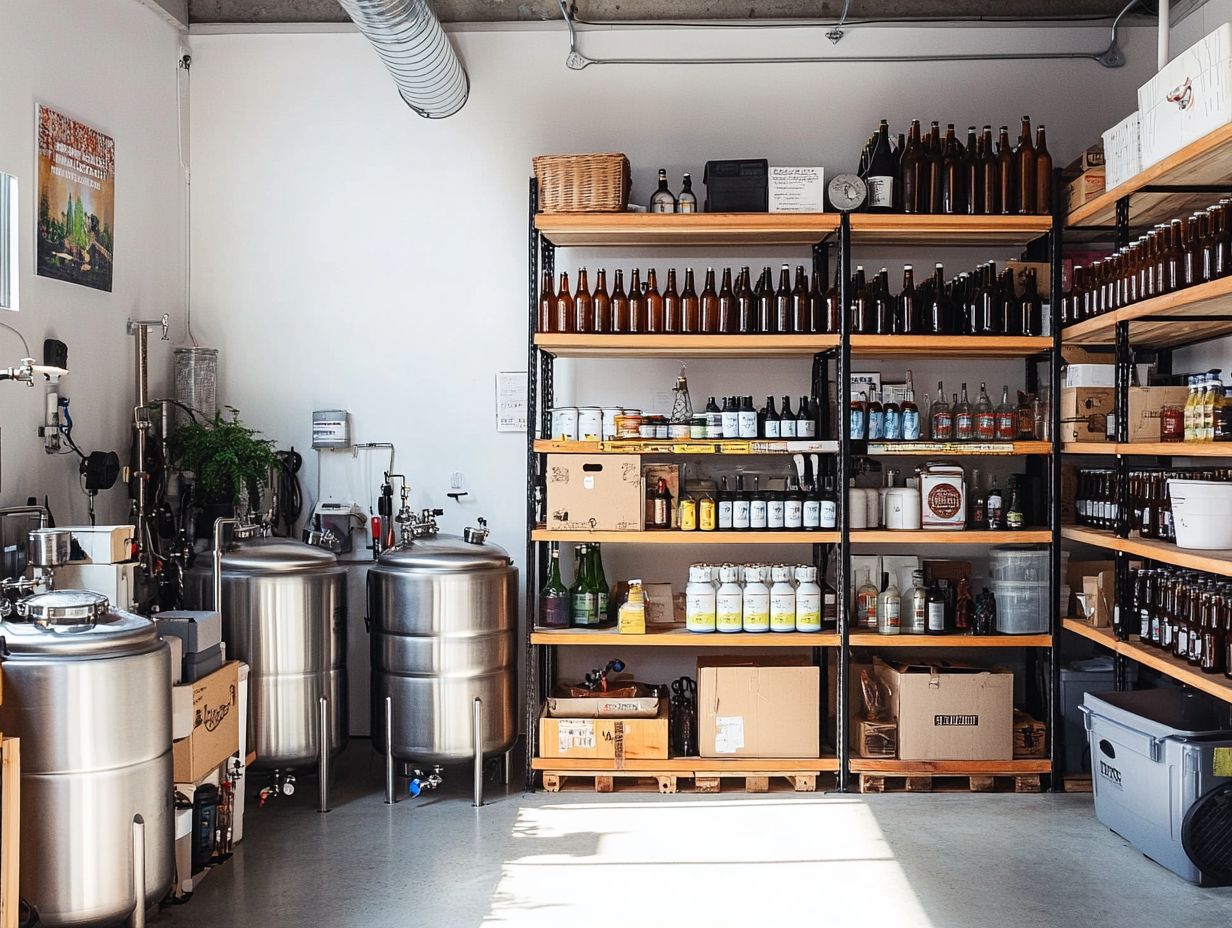
Here are some important points to remember about proper brewing equipment storage:
- Proper storage maintains the quality of brewing equipment and brewing ingredients, preventing damage and wear, and ultimately saving time and money.
- Brewing vessels, tools and utensils, and ingredients should all be properly stored to ensure their usefulness and longevity. This includes using dry airtight containers for ingredients and organizing small items effectively.
- When storing brewing equipment, consider temperature and humidity levels, light exposure, and accessibility for optimal preservation.
Why is Proper Storage Important?
Proper storage is essential for home brewers committed to crafting exceptional beer, as it greatly affects the quality of your brewing supplies, ingredients, and the entire brewing process. Effective storage solutions ensure your home brewing journey remains a delightful and straightforward endeavor. This includes storing your brew in appropriate conditions and using reliable storage systems.
By safeguarding the freshness of key components such as malted grain, hops, and yeast, you directly impact the flavor profile of your creations. A well-organized brewing space not only reduces the likelihood of errors but also elevates your efficiency on brew day. This allows you to focus on the joy of brewing. Use digital solutions to keep notes and track expiration dates for ingredients like liquid malt extract and dry malt extract.
1. Maintains Quality of Equipment
Maintaining the quality of your brewing equipment is vital for your success as a home brewer. Even a small lapse in care can lead to compromised beer quality and potential mishaps along your brewing journey.
Proper storage practices are essential for ensuring that your equipment remains functional and effective over time. For example, using the right cleaning solutions and brewing sanitizers eliminates residues that could ruin future batches and prevents contamination that might alter your carefully crafted flavor profiles. Products like Star San are excellent for maintaining cleanliness in your brewing process.
It s wise to conduct regular inventory checks to identify any signs of wear and tear or malfunctioning components. By keeping a vigilant eye on tools like your brewing kettles, fermentation vessels, and taps, you can maintain your equipment in prime condition. This ultimately elevates your overall brewing experience. An organized equipment inventory, perhaps using digital solutions, can help streamline this process.
2. Prevents Damage and Wear
Preventing damage and wear to your brewing equipment is essential for ensuring a seamless brewing process and maintaining consistent beer quality.
One of the main culprits behind equipment damage is environmental factors, like excessive humidity and fluctuating temperatures. These conditions can lead to condensation and rust, which are not your friends. Prolonged exposure to sunlight can degrade plastics and rubber components, compromising the integrity of your essential tools. Using moisture control methods, such as dehumidifiers, can be particularly beneficial.
To maintain optimal conditions for your brewing endeavors, consider strategies for moisture control. Using dehumidifiers and ensuring proper ventilation in your brewing space is crucial. Employ effective storage techniques like keeping your equipment in a cool, dry place and using protective covers to further mitigate these risks and help extend the lifespan of your valuable brewing tools. Proper moisture control will prevent issues such as clumping in dry ingredients like malt extract.
Saves Time and Money
Effective homebrew organization can save you both time and money by minimizing the risk of misplacing small supplies. Ensuring that all your necessary equipment is easily accessible for each brewing session also helps.
Investing in a robust storage system, like plastic shelving units and rolling cabinets, allows you to streamline your brewing process significantly. These storage solutions not only offer ample space for your equipment but also create an organized environment where every item has its designated spot.
Plastic shelving is great for storing malted grains and other dry ingredients effectively. Maintaining a well-organized equipment inventory is essential, as it enables you to track your ingredients and tools effortlessly.
This reduces unnecessary purchases that could strain your budget. Ultimately, adopting a systematic approach to organization fosters greater efficiency, allowing you to focus on your craft rather than searching for supplies. Don’t forget to use labeled containers! They make finding your supplies a breeze and keep your brewing sessions flowing smoothly.
Equipment Storage Essentials
In the realm of home brewing, grasping the essentials of equipment storage is crucial for cultivating an organized brewing environment. This practice not only enhances your brewing experience but also safeguards the longevity of your ingredients and tools.
From brewing vessels and fermentation tools to those small yet vital supplies like bottle caps, knowing what to store and how to store it makes all the difference in your brewing journey. For instance, you can store yeast in the fridge and hang without hooks for easy access.
Brewing Vessels
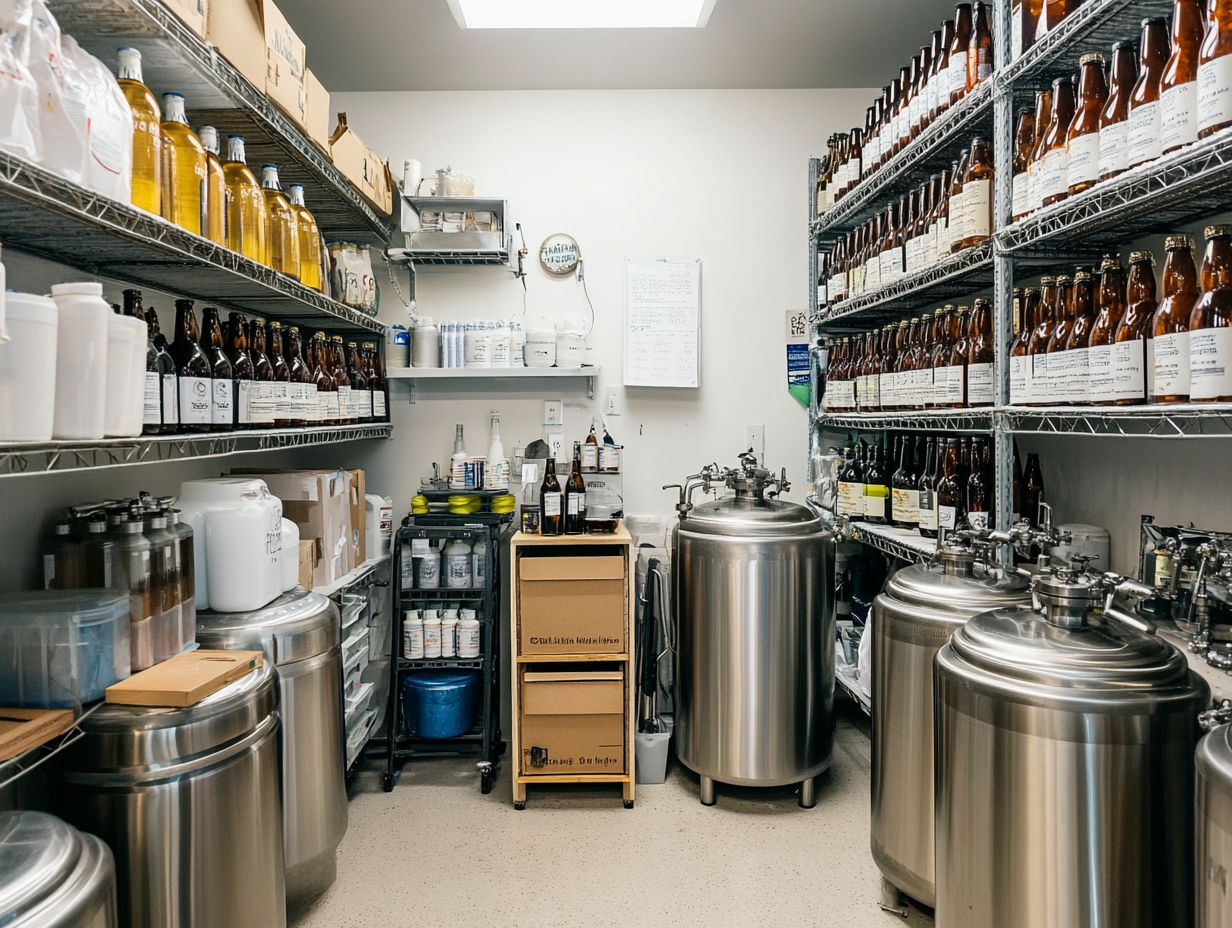
Brewing vessels are essential to the brewing process, and proper storage methods are crucial for maintaining their quality and effectiveness during beer fermentation. Employ moisture control techniques to protect these vessels from rust and contamination.
You ll find a wide variety of brewing vessels, from traditional kettles and fermentation tanks to modern conical fermenters (vessels that facilitate yeast collection and easy cleaning). Each type has its own specific storage requirements.
For example, stainless steel vessels thrive in a temperature-controlled environment to prevent oxidation and corrosion. Meanwhile, glass carboys need to be stored upright in a cool, dark place to avoid the risk of breaking.
Equally significant are the cleaning and maintenance practices. Neglecting these can lead to contamination or damaging buildup. Regular sanitization with the right cleaning agents not only extends the lifespan of your brewing vessels but also ensures the desired flavor profiles of your final product.
Adopting simple habits like rinsing immediately after use and steering clear of harsh abrasives can significantly preserve the integrity of your equipment. Products like Star San can be highly effective for sanitization.
Brewing Tools and Utensils
Your brewing tools and utensils are vital for a successful home brewing journey. Employing proper storage techniques is key to keeping them in prime condition for your future brew days.
To achieve outstanding results, you should invest in vital items such as fermenters, kettles, and stirring implements. Maintaining cleanliness throughout the process is also crucial. After each brewing session, it s imperative to thoroughly clean all your equipment with an appropriate sanitizer, as any leftover residues can adversely impact the flavor and quality of your beer.
Storing these tools in a dry, designated area, shielded from contaminants, will ensure their longevity. Employ effective storage solutions such as labeled containers and plastic shelving for efficient organization.
Organizing your brewing tools neatly in cabinets or bins can enhance your efficiency, making them easily accessible when you re ready to brew. Consider using labeled containers for smaller items like airlocks and thermometers to streamline your brewing process, eliminating clutter and confusion.
3. Ingredients
Have you ever wondered how to store your brewing ingredients effectively? Storing your brewing ingredients properly is crucial for achieving that perfect pint at home. The freshness and quality of your malted grain, hops, and yeast will directly impact the flavor profile of your beer, so it is important to get this right.
To create the ideal storage solution, keep a few key factors in mind: moisture control and temperature. For your malted grains, maintaining a cool, dry environment in airtight containers is essential to prevent spoilage and fend off pesky infestations.
Store hops in a dark, refrigerated space to safeguard their aromatic oils, which play a vital role in flavoring your brew. Consider storing your hops in the freezer for maximum freshness.
Yeast thrives in stable temperatures, so store it in the fridge to prolong its viability. By following these best practices, you will ensure that your raw ingredients remain strong and flavorful, ready for the moment you decide to craft your next batch. Remember to store yeast in a designated area in the fridge to avoid cross-contamination, which means mixing ingredients that could spoil the flavor.
Where Should Brewing Equipment be Stored?
Selecting the ideal environment for storing your brewing equipment is crucial to maintaining the integrity of your fermentation tools, brewing vessels, and other essentials. You will want to consider the following key factors:
- Temperature
- Humidity levels
- Light exposure
- Ease of access
Each of these elements plays a significant role in ensuring your equipment remains in optimal condition, ready for your next brewing adventure. Keeping a digital log of your equipment’s condition and necessary maintenance can be very helpful.
1. Temperature and Humidity Levels
Controlling temperature and humidity levels is crucial for storing brewing equipment effectively, as both factors can dramatically influence the quality and longevity of your brewing supplies.
By maintaining ideal conditions, you ensure that essential ingredients like hops, malted grains, and yeast stay fresh and strong. For most brewing items, a temperature range of 60 F to 75 F is recommended, while humidity levels should ideally remain below 60% to avoid mold and spoilage.
High humidity can lead to clumping, which can throw off your measurements and ultimately compromise brew quality. On the other hand, excessively dry conditions can dehydrate your ingredients, stripping away their flavor and aroma.
Therefore, keeping a vigilant eye on these environmental factors is vital, whether you are a homebrewer or running a commercial brewery, to achieve optimal results in each batch of brewing beer.
2. Light Exposure
Minimizing light exposure is crucial when storing quality ingredients and brewing supplies. Excessive light can degrade essential components of the brewing process, and you certainly do not want that.
For instance, light can negatively affect your brewing ingredients like malted grain, hops, or yeast. Light, especially UV rays, can trigger chemical reactions that negatively impact the freshness and flavor profiles of your malt, hops, and even water, resulting in inconsistent brews.
To protect these vital brewing ingredients, it is essential to store them in opaque containers or utilize dark, cool storage areas. While glass and plastic are common choices, they can allow light to seep in, so opt for aluminum or specially designed dark storage units, especially for malt extract and brewing salts.
It’s wise to keep your brewing equipment, like fermenters and kegs, in dim environments as well. Exposure to light can compromise the integrity of any residual brew or flavor compounds. By following these storage guidelines, you can create optimal conditions for consistently excellent brewing outcomes and avoid common brewing mistakes.
Now that you know how to store your brewing supplies, it is time to brew that perfect pint!
3. Accessibility
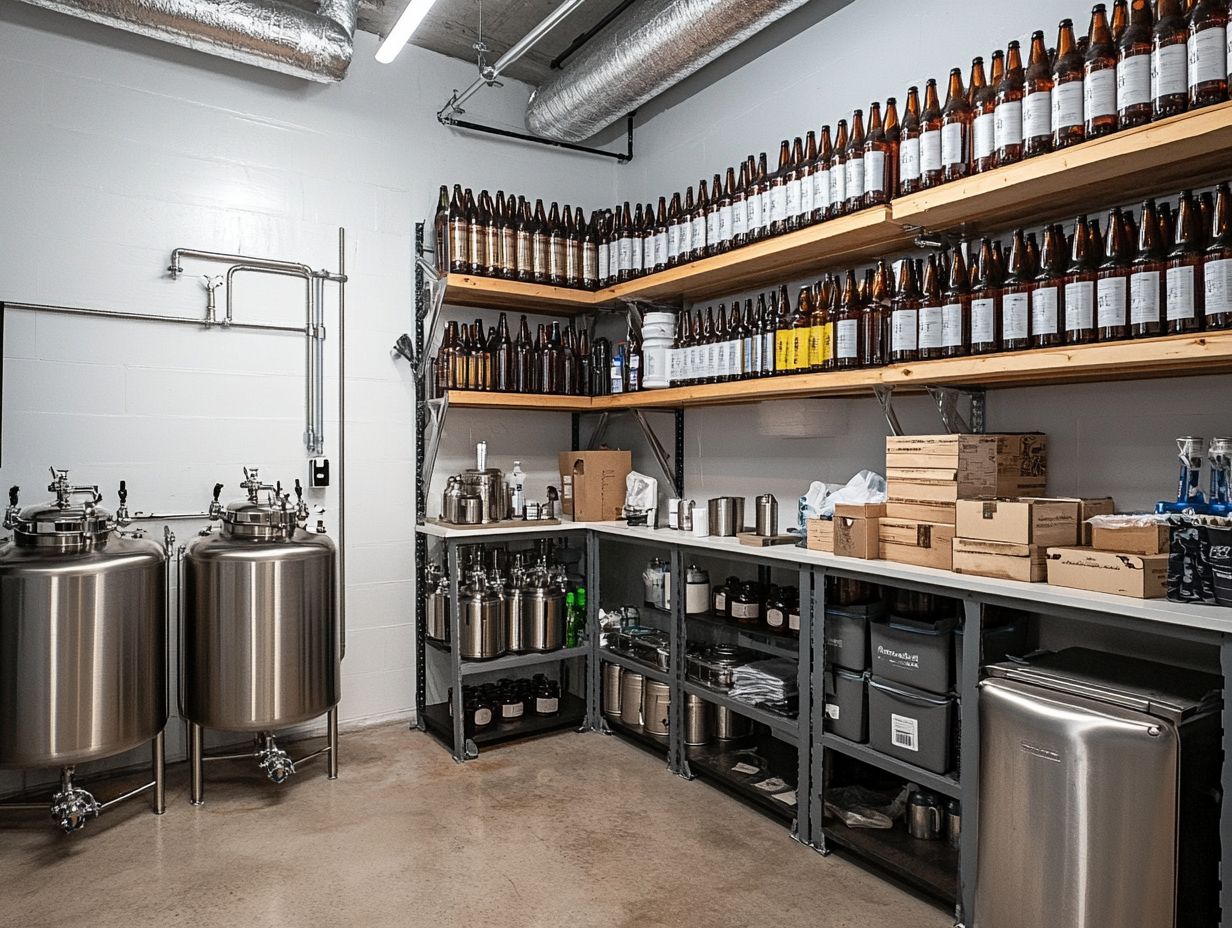
Ensuring that you have easy access to brewing equipment and ingredients is essential for your home brewing endeavors. This not only streamlines the brewing process but also minimizes any potential delays on brew days, making it a more enjoyable pastime.
A well-organized brewing space enhances efficiency and elevates your overall enjoyment of the brewing experience. Consider practical solutions like plastic shelving to create designated spots for your supplies, making them effortlessly locatable when you’re gearing up for a session. Incorporating rolling cabinets adds a layer of flexibility, allowing you to bring materials closer to your brewing station as needed.
You can also use digital solutions to keep track of your equipment inventory and homebrew organization. By implementing clear labeling methods and categorizing your items think hops, malt, and cleaning supplies you can significantly speed up your workflow.
An efficient homebrew organization system ultimately leads to more enjoyable and successful brewing sessions, transforming your craft into a seamless and rewarding experience. Organizing small supplies like bottle caps and using dedicated storage solutions can also enhance your brewing experience.
How to Properly Store Brewing Equipment and Ingredients?
Want to keep your brewing equipment in top shape? Follow these simple steps! To properly store your brewing equipment, it is essential to follow several key steps. Begin by ensuring that all your equipment is thoroughly clean and completely dry. This prevents any unwanted residue or moisture from compromising your supplies. Using a reliable brewing sanitizer like Star San can ensure cleanliness.
Next, utilize airtight containers for sensitive ingredients to maintain their freshness and quality. Implementing a systematic approach to labeling and organizing your brewing supplies, including using dry airtight containers, will enhance your efficiency and make the brewing process more enjoyable.
With these practices in place, you’ll elevate your brewing experience to a whole new level, ensuring you can store your brew effectively.
1. Clean and Dry Equipment
Cleaning and drying your equipment is an essential step in storing brewing supplies. Residual moisture or contaminants can lead to spoilage, significantly affecting the quality of your ingredients and the flavor profile of your beer.
Ensuring that all your brewing tools ranging from fermenters to kegs are meticulously cleaned with appropriate solutions is crucial for maintaining a sanitary environment. One effective method is to use non-toxic cleaners that thoroughly eliminate yeast and bacterial residues while steering clear of harsh chemicals that could leave harmful traces behind.
After cleaning, employing proper drying techniques, such as air drying or using a dedicated drying rack, is vital to prevent any moisture accumulation. This step not only protects the integrity of your brewing setup but also enhances the overall flavor profile of your final product.
Stay diligent with your maintenance routines to ensure your brewing excellence! It’s the little things that make a big difference in brewing excellence. Also, consider using digital solutions to keep notes on maintenance routines and brewing tips for future reference.
2. Use Airtight Containers
Using airtight containers is essential for home brewers, as they safeguard your malted grains, brewing salts, and other sensitive ingredients from moisture, pests, and unwanted air exposure. Also, store yeast in similar containers to maintain its viability.
You ll find various types of airtight containers, each providing distinct advantages tailored to your specific brewing needs. For example, glass jars with rubber gaskets are superb for keeping hops and spices fresh, while food-grade plastic bins excel at bulk storage of grains, ensuring they stay dry and uncontaminated.
Vacuum-sealed bags are another valuable option; they compress ingredients, maximizing your storage space while preventing any loss of flavor. Additionally, consider using dry malt extract in these containers for extended shelf life.
Mastering proper sealing techniques not only extends the lifespan of your ingredients but can also elevate the quality of your final brew. Therefore, investing in the right airtight storage solutions is fundamental for any serious brewer aspiring to achieve exceptional results. Store malted grains and liquid malt extract properly to maintain their quality.
3. Label and Organize
Labeling and organizing your brewing supplies is a smart strategy to streamline the brewing process. This ensures you can swiftly locate and access both small supplies and critical ingredients when needed. Consider organizing by use or by brew day requirements.
By adopting a variety of labeling methods such as color coding or utilizing clear containers you can establish a visual system that allows for quick identification of specific items at a glance.
Organization techniques, such as grouping similar supplies together by type, frequency of use, or ingredient similarities, can significantly boost your efficiency. Hang without hooks if necessary to maximize your space.
Maintaining an inventory list not only assists you in locating your supplies but also helps avert potential brewing blunders that may arise from running out of essential ingredients or forgetting what you already have on hand. Being prepared means you can focus on crafting the beer of your dreams! Using digital solutions can help keep your inventory up-to-date and accurate.
4. Rotate Stock
Rotating your stock is vital for brewing great beer! This practice ensures that your ingredients are used before their expiration dates, which helps maintain the quality and flavor profile of your beer. It’s crucial to keep notes on when you purchase and use your ingredients.
By implementing effective stock rotation practices, you can minimize waste and enhance your brewing efficiency. This means organizing your ingredients so that older items are used first essentially adopting a ‘first in, first out’ method. The importance of this approach cannot be overstated; stale hops or malt can drastically alter the taste of your final product. Also, consider using brewing salts and other additives in a timely manner.
You can get started by:
- Label containers with purchase or expiration dates,
- Create a clear inventory list,
- Regularly check your supplies.
These straightforward strategies will help keep the freshest ingredients at the forefront, leading to a consistently enjoyable brewing experience. Proper stock rotation is key to efficient homebrew storage.
Frequently Asked Questions
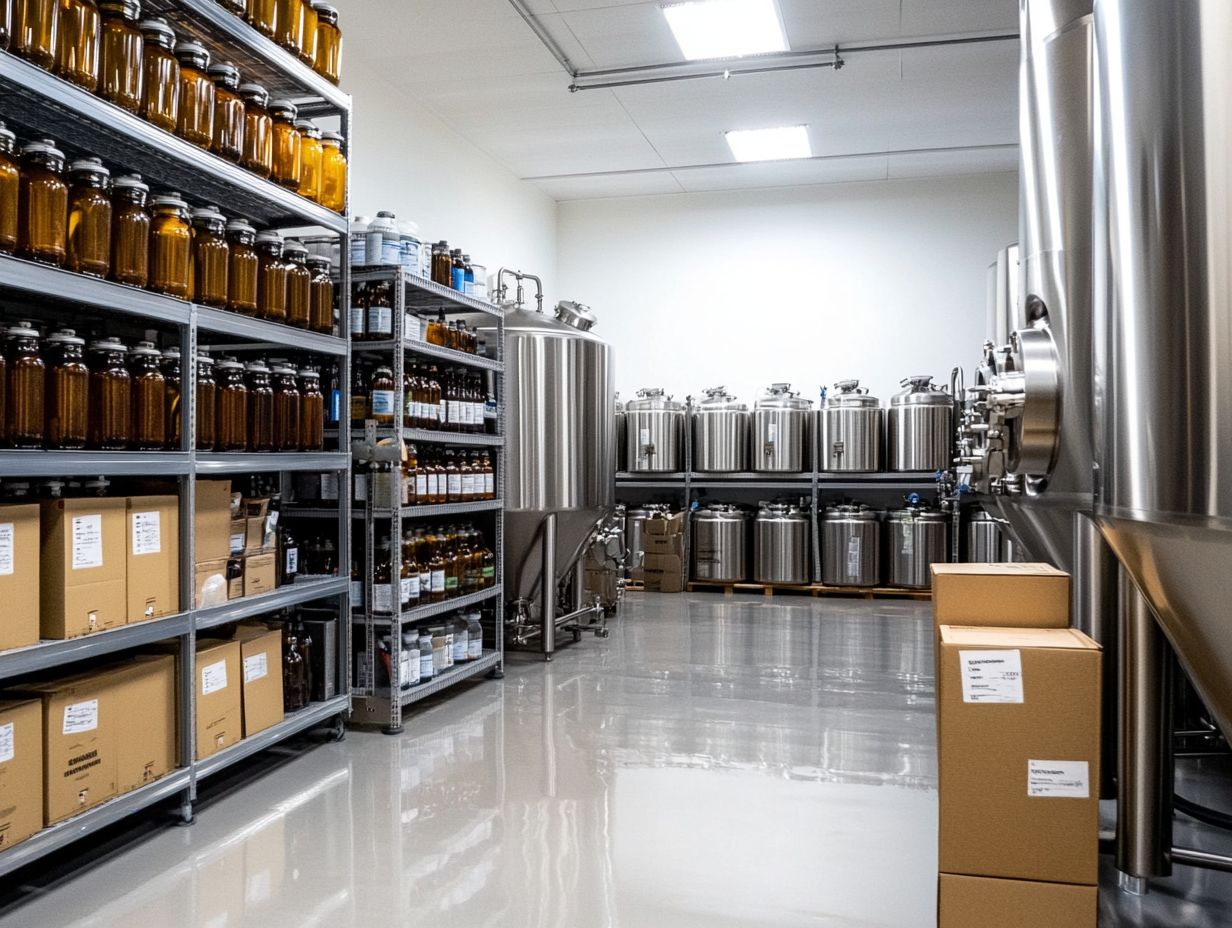
What are the best practices for storing brewing equipment?
The best practices for storing brewing equipment include cleaning and drying the equipment thoroughly before storage, using airtight containers or bags to prevent moisture and pests, and storing in a cool, dry place away from direct sunlight. Also, consider using moisture control solutions to avoid deterioration.
How should I clean my brewing equipment before storing?
To clean your brewing equipment before storing, use a non-abrasive cleaner and hot water to wash away any residue or build-up. Rinse thoroughly and allow the equipment to air dry completely before storing. A good cleaning solution can make this process more efficient.
Can I store my brewing equipment in the fridge or freezer?
It is generally not recommended to store brewing equipment in the fridge or freezer, as the constant temperature changes and humidity can affect the quality and longevity of the equipment. Store yeast and other sensitive items in the fridge instead.
What is the best way to prevent pests from getting into my stored brewing equipment?
Using airtight containers or bags is the best way to prevent pests from getting into your stored brewing equipment. Make sure to check the containers or bags regularly for any signs of pests and replace them if necessary. Store malted grains and brewer’s yeast in a cool, dry place to extend their shelf life.
Should I store my brewing equipment in a specific order?
Storing your brewing equipment in a specific order, such as largest to smallest or most frequently used to least frequently used, can help with organization and ease of access. However, as long as the equipment is properly cleaned and stored, there is no specific order that is necessary. This can be part of a larger storage system that includes fermentation tools and brewing equipment.
For more tips and best practices on brewing, subscribe to our newsletter!
How often should I check on my stored brewing equipment?
You should check your brewing equipment every few months to ensure it remains in good condition. In humid or hot climates, checking more often is helpful to spot any issues early.
This regular check can prevent brewing mistakes in the future. Don’t let your brewing equipment fall into disrepair regular checks can save your future brews!

